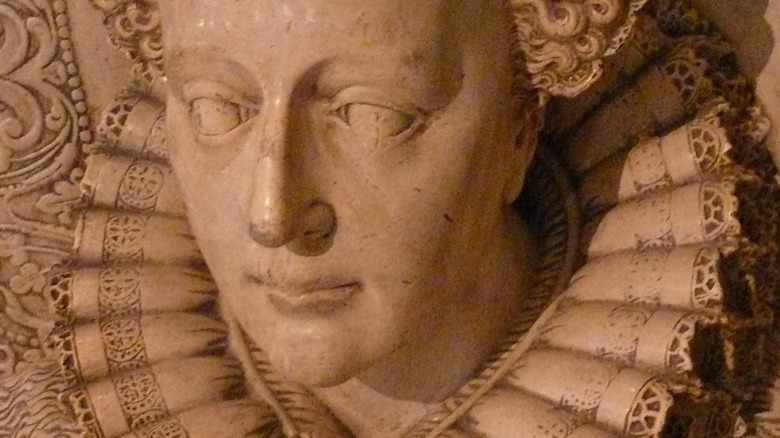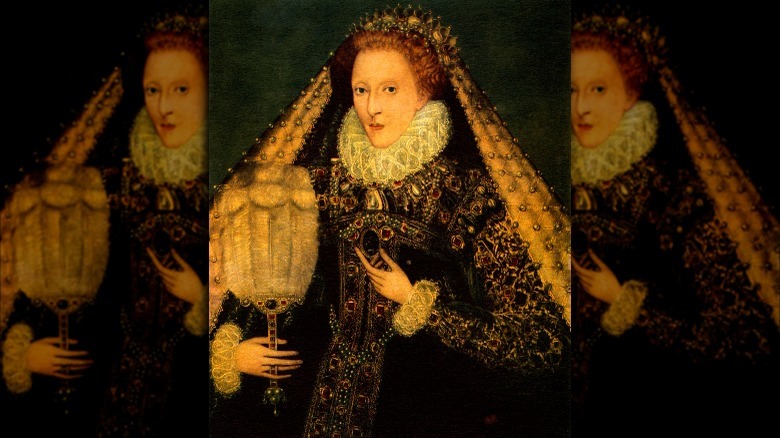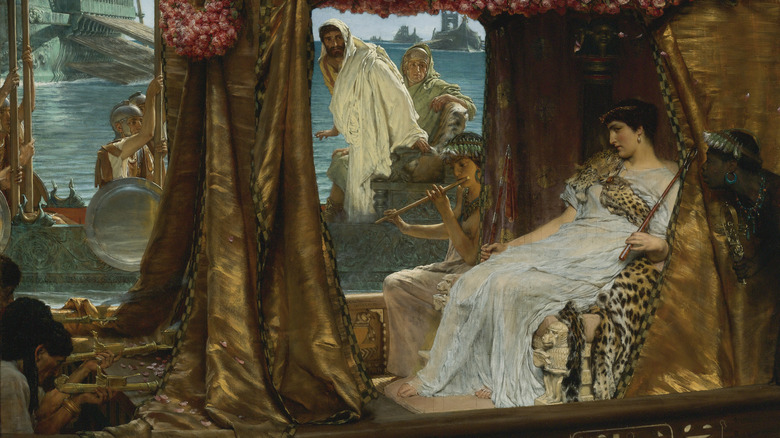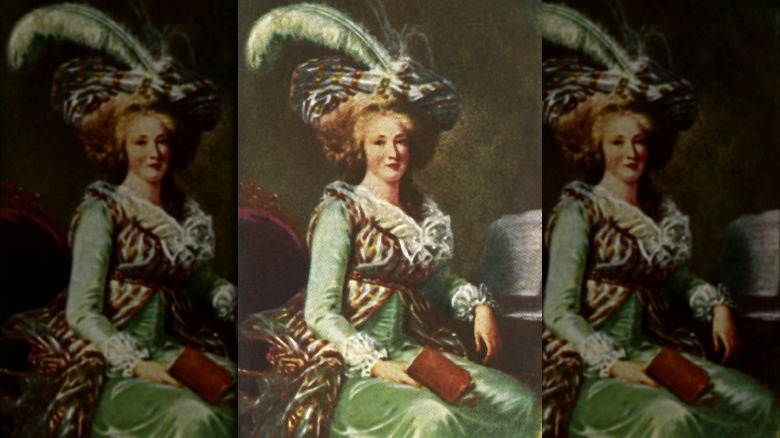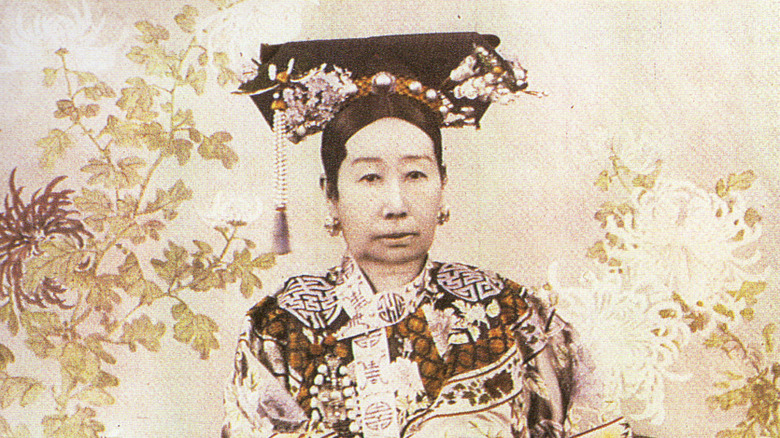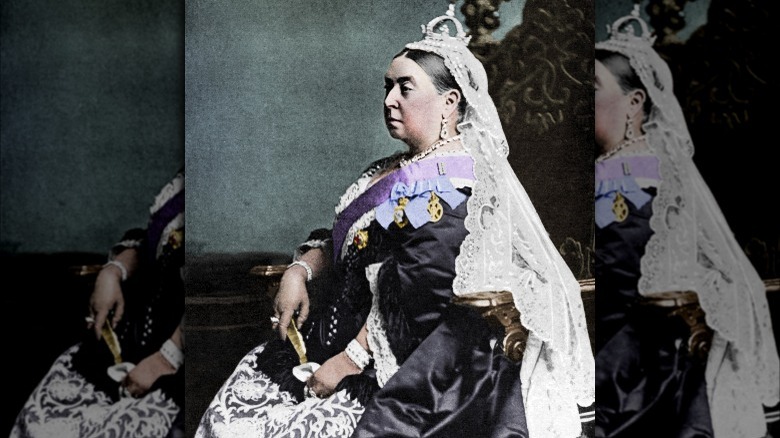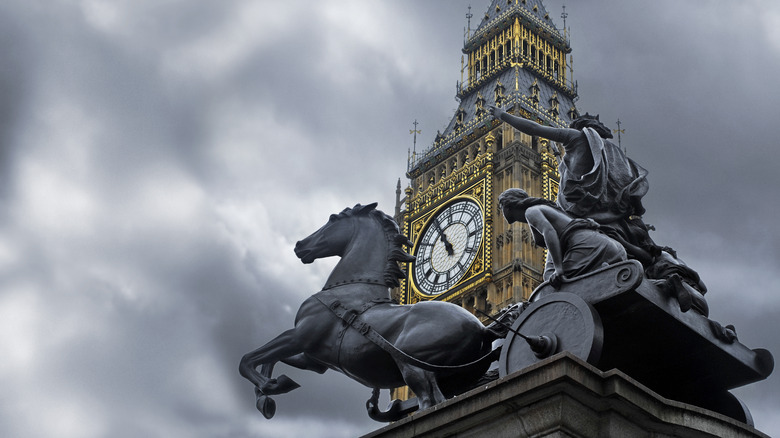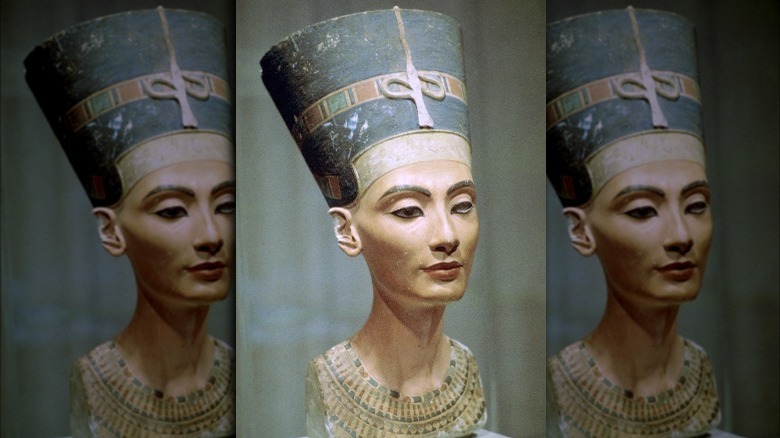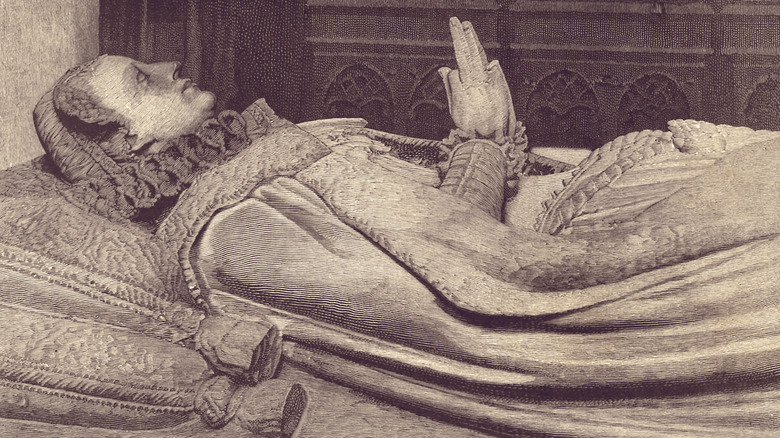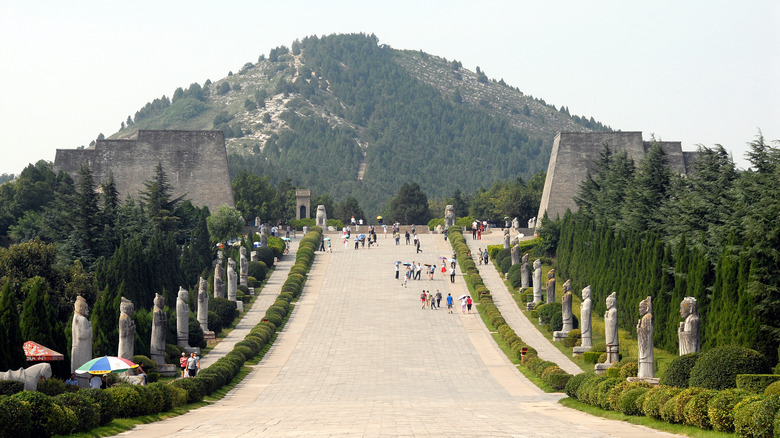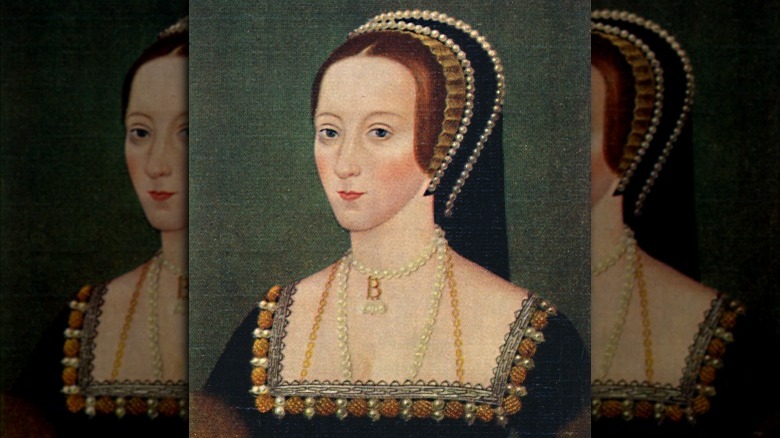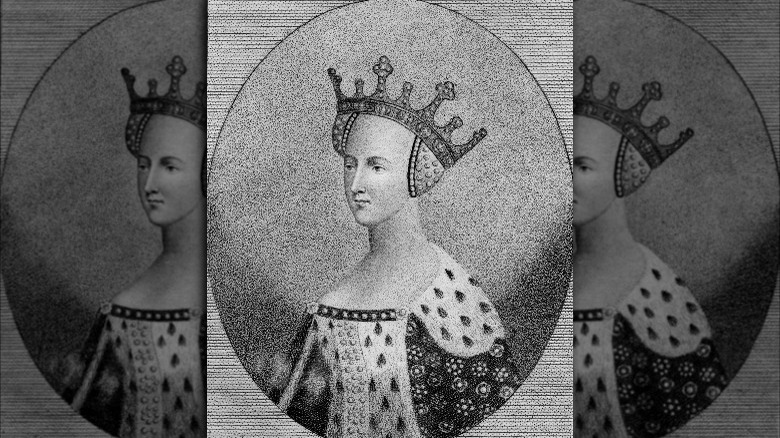Here's What Happened To The Bodies Of The Most Famous Queens In History
Human funeral traditions are pretty different wherever you go on planet Earth, but the bodies of royal people have always received the weirdest treatment after death (if you don't count murder victims or the condemned, who are and were sometimes sent to the next world in pretty horrific ways). Anyway, over the years royal bodies have gotten posthumous treatments that run the gamut from burial to mummification to semi-permanent display. Sometimes the living were just acting on tradition or the wishes of the deceased, but sometimes the deceased had no input into what would happen to their mortal coil after it was good and shuffled off.
Whether they were loved or hated, the bodies of history's most famous queens all had one more purpose to fill before they got to finally rest in peace — they had to make some kind of a statement for the benefit of the people who either thrived or suffered under their rule. You might know how these famous queens died, but here's what really happened to them in the end.
Elizabeth I hung around for a few weeks before she was buried
One thing a lot of royal burials had in common was that there didn't seem to be a huge sense of urgency to, you know, get the bodies in the ground. William the Conqueror's body famously exploded as it was being lowered into his tomb, mostly because it had traveled more than 70 miles and then sat around in hot weather for a while.
More than 500 years later, Queen Elizabeth I died at Richmond Palace. Fortunately, it was still early spring, so the weather wasn't working against the funeral planners, who took her body to Whitehall Palace and left it there for three weeks. At least one source claimed Elizabeth also exploded in her coffin, but the Royal Museum of Greenwich notes the witness wasn't an especially reliable one.
After her time at Whitehall, Elizabeth was taken on procession through the streets of London. The effigy of the dead queen on top of her coffin was evidently so realistic that people who saw it went all swoony. After the funeral, Elizabeth was interred in Westminster Abbey in the vault of her grandfather, Henry VII, but three years later she was moved and interred under a monument built in her honor by James I, son of Mary Queen of Scots, who Elizabeth had executed 20 years earlier. It's worth noting that James also had his mother reinterred at Westminster Abbey, and that her monument was bigger.
Cleopatra was probably mummified, but we'll never know
This one can only ever be pure speculation, because no one knows what happened to the body of Egypt's most famous queen. That doesn't stop archaeologists from running around telling everyone that they found the tomb of Cleopatra. This happened back in December of 2020, when a team uncovered an "undisturbed tomb decorated in gold leaf" at Taposiris Magna, roughly 31 miles west of Alexandria, Egypt, but since then they've been kind of awkwardly silent on the details.
According to Live Science, some scholars think it's unlikely Cleopatra's tomb will ever be found, because she was probably buried near her palace in Alexandria, and her palace and the surrounding area are now under water. If that's true, then over the years earthquakes and salt water would have almost certainly destroyed her remains and most of the evidence inside the tomb. Her contemporaries have noted that she was buried with her famous lover, Mark Antony, who ended his own life a few days before she did, but there's some disagreement about whether they were both mummified or if Mark Antony was cremated in Roman tradition. Sadly, we probably won't ever know the answer.
Let them eat dirt
Not all queens got the royal treatment after death. Marie Antoinette was not fortunate enough to be buried with all her jewels and furs and cakes or whatever, because Marie Antoinette was executed. According to History Extra, the queen and her husband Louis XVI were captured by French revolutionaries in August of 1792, and were later put on trial for crimes of treason. Louis was executed by guillotine in January of the following year, but Marie languished in captivity for months until the revolutionaries finally had the stomach to put her on trial, too. The queen, as expected, was also convicted of treason and executed in October of 1793.
Marie Antoinette wasn't just a dead queen; she was also considered a dead murderer (amongst her crimes: the deaths of "thousands of French-men"). So her body and the head that used to be attached to it got treated like the body and head of any common murderer. First, onlookers rushed to the guillotine so they could soak up her blood with their handkerchiefs, because ... people are generally horrible. Her head was held aloft as the crowd cried "vive la Republique!" and then her body was tossed into an unmarked grave where it lay until the early 19th century, when both she and her husband were exhumed and moved to the Basilica of St Denis.
You can't really take it with you, though
The biggest problem facing any royal corpse is that you want to be buried with all your unnecessarily opulent stuff, but you can be pretty sure eventually someone will loot all your unnecessarily opulent stuff and as a corpse there's really not a whole lot you can do about it. Still, wealthy monarchs usually chose to get buried with all their stuff anyway because a 99.9% chance of being robbed is always preferable to giving your wealth away to people who might actually need it.
Anyway, according to Encyclopedia.com, Empress Dowager Cixi began her political career as a low-ranking concubine and by the mid-1800s was effectively ruling China. After her death she was given an emperor's funeral, complete with a year-long schedule of various royal ceremonies prior to her actual burial in the Eastern Mausoleum in Hebei Province. She was only there a couple of decades before the tomb was captured by the army of Sun Dianying, who blew off the door and took all of Cixi's stuff, including priceless jadeite figures and her royal robes and jewelry. They even opened up her mouth to remove the pearl that was supposed to keep her body from decomposing. When they were done, they threw her corpse on the ground. To be fair, someone did come along later and clean up the mess, and 1949 the tomb was restored by the communist Chinese government.
Mumtaz Mahal was placed inside the seventh wonder of the world
Empress Mumtaz Mahal isn't super well-known outside of India, but the monument that was built in her honor is one of the seven modern wonders of the world, so that kind of makes up for it. Her real name was Arjumand Banu Begum, but her husband called her "Chosen One of the Palace," and when she died giving birth to her 13th child her husband had her temporarily buried on the banks of the Tapti River. Later that year she was disinterred and carried in a golden casket to Agra, where she found a second resting place on the banks of another river.
Meanwhile, her husband began making plans to build the grand mausoleum that would become her third and final resting place. It took 22 years to finish the Taj Mahal, but today it's one of the most famous structures in India.
According to the Times of India, popular legend says Mumtaz Mahal's body was kept in an airtight tin box full of aromatic herbs like camphor and sandalwood to stop it from decomposing. The herbs were thought to create a vacuum inside the airtight container that would help preserve her body, you know, kind of like a giant Food Saver for corpses. Twenty-two years after her death her body was finally placed inside a small dome in the center of the Taj Mahal.
Queen Victoria had some weird requests
Queen Victoria's love for her husband Albert was famous during her life, and even in death she made sure to let him know he hadn't been forgotten. Until Queen Elizabeth II, Victoria's reign had been the longest in British history, and many of her subjects had never known a time when she wasn't the queen, which meant she could ask for pretty much whatever she wanted at her funeral. Her most visible request was that everything be white instead of black — she was buried in her white wedding dress and her coffin was covered in a white pall. She also requested a number of ordinary items in her coffin including jewelry, photographs, shawls, and letters. But according to Ripley's, she also wanted a cast of her deceased husband's hand and his dressing gown. And she had a photo of another man in there too, along with a lock of his hair and his mother's wedding ring. So it's safe to say it was a bit crowded inside the queen's coffin.
Queen Victoria also didn't lie in state, which may or may not have had anything to do with the exploding corpses of past monarchs, and she wasn't buried at Westminster Abbey like kings and queens before her. Instead, Victoria was interred at the Royal Mausoleum in Frogmore half a mile south of Windsor Castle, near her beloved husband Albert who'd died 40 years earlier.
Boudicca might be the woman buried in this lavish tomb
Some queens were beloved by their people but not so much by their sworn enemies, so their tombs had to be sort of incognito. Boudicca was the most famous Celtic queen of her time, or any time, really. After the Romans told her she wasn't allowed to inherit her husband's kingdom and then publicly beat her and assaulted her two daughters, she decided she'd had quite enough of Roman rule. Boudicca beat the Romans in three major battles, but they were the Romans, and it was kind of hard to keep up that kind of momentum against an army that had kind of a bottomless supply of soldiers. According to Ancient Origins, history is a bit shaky on what happened after Boudicca's eventual defeat. She either drank from a poisoned chalice and died or she died of natural causes.
History is also kind of shaky on what happened to her body. She might have been buried at Stonehenge, or in Norfolk, or maybe under a platform at King's Cross Station in London (the station was obviously not there at the time). Some scholars think her tomb is actually at Birdlip in Gloucestershire, a site that's already been excavated. The tomb contains the bones of a woman and some lavish grave goods. It also contains the bodies of two other women, who some scholars think might be Boudicca's daughters. The time period fits, too, as does the location — some historians believe Boudicca may have been born in the Birdlip area.
Nefertiti was also mummified, but that's where the trail goes cold
Egyptian monarchs were mummified because Egyptians believed a person couldn't enter the afterlife without an intact body, which is kind of problematic since there are very few examples of perfectly preserved mummies and certainly not any from the time of the pharaohs. So it seems like the Egyptian afterlife might be a lonely place.
Anyway, in order for a body to remain perfectly preserved forever, it also had to be protected from people who might not care so much about the integrity of the ex-pharaoh's body. That may be why so many tombs have never been found — because pharaohs sometimes decided a hidden tomb was the best way to ensure a long afterlife. According to Nature, back in early 2020 archaeologists did a radar survey of King Tut's tomb and concluded that there's an unexcavated corridor not far from Tut's burial chamber. Archaeologists hope it might lead to the tomb of Nefertiti, who was connected to Tut by marriage and may have ruled just before he did.
That appears to be the sum total of the evidence so far, though, and not everyone thinks the radar survey is especially compelling. "[Ground penetrating radar] never made any discovery at any site in Egypt," said archaeologist Zahi Hawass. Of course, Hawass is also looking for Nefertiti's tomb, so take that with a grain of salt.
Mary, Queen of Scots got an upgrade 25 years after her death
As the polar opposite of her cousin Elizabeth I, Mary, Queen of Scots was doomed to have a sucky life and a sucky death. She was very briefly the queen of both France and Scotland, but after the demise of her husband the French king, things went downhill and kept going downhill from there. Mary eventually sought refuge from her own people at Elizabeth's court, but Elizabeth never trusted her. Nineteen years later, Mary was sentenced to death for plotting to overthrow Elizabeth.
Her execution was awful, as executions go. It took three blows to actually sever her head from her body and witnesses reported that her lips kept moving for at least 15 minutes after her death. According to History Scotland, Elizabeth had Mary's remains interred at Peterborough Cathedral, which is also the burial place of Henry VIII's first wife, Katherine of Aragon. (In case you need a refresher, Elizabeth's mother Anne Boleyn was Katherine's romantic rival, so although Mary's burial place was not nearly as bad as being thrown in an unmarked grave, it was also kind of a snub).
That changed when Mary's son James succeeded her cousin in 1603. He had a proper tomb made for his deceased mom at Westminster Abbey, and in a kind of reverse snub she's now located next door to Elizabeth. We can only guess how Elizabeth would have felt about that.
Wu Zetian is one of the few monarchs who didn't get robbed after death
Wu Zetian ruled China in the 7th century, during a time when women almost never got to have real power. So it's really not clear what kind of a ruler she was because she got vilified all over the place, which frankly is really not that uncommon for today's female rulers, either. Anyway, according to Smithsonian, she managed to hold onto power for a long time — for a while, she ruled from the sidelines in her husband's name, then in her son's name. Then in 690 she became an empress in her own right.
Whoever planned Wu Zetian's burial place put a lot of thought into it. She is interred with her husband at the Qianling Mausoleum, which was built into the side of a mountain at the end of a long path lined with a bunch of imposing statues of animals and Chinese officials (just in case the animals don't frighten you all by themselves). The path also winds between two hills that have watchtowers strategically placed on top, you know, in case you get up to some funny business. At least 17 different elaborate tomb raiding operations have been launched against Wu Zetian's final resting place, and they've all failed. One even involved an army of 400,000, who didn't find the tomb's entrance despite digging a 131-foot deep ditch in front of it. To this day, Wu Zetian's tomb has never been opened.
Anne Boleyn was buried hastily and then forgotten
Henry VIII was cruel to all of his wives, but poor Anne Boleyn couldn't have possibly seen her fate coming, because queens didn't tend to get executed while their husbands were still in power. Even her own rival, Katherine of Aragon, was simply divorced and discarded, you know, vs. publicly relieved of her head. Well, at least Henry was thoughtful enough to have Anne executed with a sharp sword instead of an ax.
Anyway, according to Royal Central, after her execution Anne Boleyn was placed in a chest made out of elm and then quickly buried in an unmarked grave at the Chapel of St. Peter and Vincula, not far from where she'd lost her head. She stayed there until 1876, when Queen Victoria approved a restoration project and her grave (along with the graves of other executed Henry VIII victims like Katherine Howard and Margaret Pole) was disturbed. A man named Dr. Mouat rather unscientifically identified her remains based on the small size of one skeleton's vertebrae (you know, because of her "little neck"), but it's unclear if the remains were actually Anne's or not. It's not like forensic science was especially well advanced during the Victorian era.
Catherine of Valois wasn't a super famous queen, but jeez
This is probably the least famous monarch on our list, but she deserves a mention because of the really strange things that happened to her body after her death. Catherine of Valois was the wife of Henry V of England — she was officially queen from 1420 until Henry's death in 1422. She later went on to have children (who may or may not have been legitimate) with Owen Tudor, and together they became the founders of the Tudor dynasty. So even though most people don't know her name, they sure as heck know the names of her descendants.
According to The Diary of Samuel Pepys, Catherine died in 1437 and was interred in the Lady Chapel at Westminster Abbey. She rested in peace until someone removed the alabaster memorial from her tomb, possibly on the orders of her grandson, Henry VII, who never felt great about being possibly illegitimately descended from royalty through his grandmother. Whoever removed the memorial also raised the lid of her coffin, and instead of putting the lid back so she could go on resting in peace she was left to become a macabre tourist attraction. A century and a half later, the diarist Samuel Pepys picked up her corpse and kissed it on the lips, but it wasn't until the reign of Queen Victoria that it occurred to anyone to properly reinter the mother of the Tudor dynasty.
